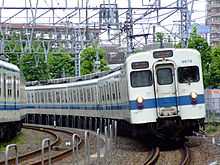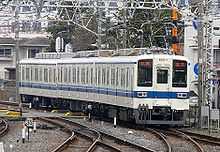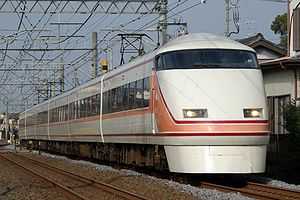Tobu 8000 series
| Tobu 8000 series | |
|---|---|
 10-car formation on the Tojo Line, June 2008 | |
| In service | 1963–Present |
| Manufacturer | Alna Kōki, Fuji Heavy Industries, Kisha Seizō, Nippon Sharyo, Tokyu Car Corporation |
| Constructed | 1963–1983 |
| Refurbishment | 1986–2008 |
| Number built | 712 vehicles |
| Number in service | 424 vehicles (as of April 2013) |
| Formation | 2/3/4/6/8 cars per trainset[1] |
| Operator | Tobu Railway |
| Depot(s) | Kasukabe, Nanakōdai, Tatebayashi, Shinrinkōen, Shin-Tochigi[1] |
| Line(s) served | Isesaki Line, Kameido Line, Kiryu Line, Noda Line, Sano Line, Tojo Line, Ogose Line |
| Specifications | |
| Car body construction | Steel |
| Car length | 20 m (65 ft 7 in) |
| Width | 2,850 mm (9 ft 4 in) |
| Doors | 4 pairs per side |
| Maximum speed | 100 km/h (60 mph) |
| Electric system(s) | 1,500 V DC |
| Current collection method | Overhead lines |
| Track gauge | 1,067 mm (3 ft 6 in) |
The Tobu 8000 series (東武8000系 Tōbu 8000-kei) is a commuter electric multiple unit (EMU) train type operated by the private railway operator Tobu Railway in Japan since 1963.
A total of 712 vehicles were built between 1963 and 1983, making this the most numerous EMU type operated by any private railway operator in Japan.[2]
Operations
Isesaki Line
The Isesaki Line fleet consists of 2-, 4-, and 6-car trainsets based at Kasukabe, Tatebayashi, and Shin-Tochigi depots. A fleet of 3-car 800 and 850 series trains converted from 8000 series units is also based at Tatebayashi Depot.
Kameido Line

The Kameido Line uses 2-car trainsets modified for driver-only operation.
Kiryu Line
Kiryu Line services include 800 and 850 series 3-car driver-only-operation sets introduced from the start of the revised timetable on 18 March 2006.[2]
Noda Line
The Noda Line fleet based at Nanakōdai Depot consists of 2-, 4-, and 6-car trainsets.
Sano Line
Sano Line services include 800 and 850 series 3-car driver-only-operation sets introduced from the start of the revised timetable on 18 March 2006.[2]
Tojo Line

The Tōjō Line fleet based at Shinrinkōen Depot consists of 2-, 4-, 6-, and 8-car trainsets. These are operated as 10-car formations for services to/from Ikebukuro and as 4-car formations for local driver-only-operation services north of Ogawamachi.
Ogose Line

From the start of the revised timetable on 14 June 2008, only refurbished 4-car driver-only-operation sets are used on the Ogose Line.
History
Production
The first 8000 series appeared in November 1963 as 4-car sets. These were joined from December 1964 by 2-car sets (formed MoHa8500 + KuHa8600). Between 1971 and 1972, 14 pairs of additional intermediate cars (SaHa8700 + MoHa8800) were built and inserted into 4-car sets 8101 to 8114 to lengthen them to six cars. 8000 series trains built up to this point were not equipped with air-conditioning, but from June 1972, three 6-car air-conditioned sets (8156 to 8158) were delivered. The originally non-fitted sets were also modified with air-conditioning from October 1973 until 1983 at the Alna Kōki (now Alna Sharyō) factory in Osaka and Tsuha Sharyō factory in Nishiarai, Tokyo.
In May 1977, the first 8-car 8000 series set (8173) was delivered for use on the Tojo Line.
October 1979 saw the last two digits of individual car running numbers exceed 99, resulting in some cars receiving 5-digit (8xxxx) running numbers.
The last two sets built, 81120 and 8580, were delivered in 1983.[2]
The fleet changes between 1963, when the first sets were built, and 1983, when construction ended, are shown below.[3]
| Fiscal year | 2-car sets | 4-car sets | 6-car sets | 8-car sets | Total vehicles |
|---|---|---|---|---|---|
| 1963 | 0 | 15 | 0 | 0 | 60 |
| 1964 | 8 | 15 | 0 | 0 | 76 |
| 1965 | 21 | 21 | 0 | 0 | 126 |
| 1966 | 27 | 27 | 0 | 0 | 162 |
| 1967 | 39 | 36 | 0 | 0 | 222 |
| 1968 | 47 | 43 | 0 | 0 | 266 |
| 1969 | 58 | 51 | 0 | 0 | 320 |
| 1970 | 62 | 55 | 0 | 0 | 344 |
| 1971 | 62 | 42 | 13 | 0 | 370 |
| 1972 | 62 | 41 | 17 | 0 | 390 |
| 1973 | 63 | 41 | 22 | 0 | 422 |
| 1974 | 68 | 41 | 25 | 0 | 450 |
| 1976 | 70 | 41 | 31 | 0 | 490 |
| 1977 | 70 | 41 | 31 | 5 | 530 |
| 1978 | 70 | 42 | 31 | 9 | 566 |
| 1979 | 70 | 42 | 31 | 14 | 606 |
| 1980 | 73 | 45 | 32 | 16 | 646 |
| 1981 | 75 | 47 | 33 | 16 | 664 |
| 1982 | 80 | 50 | 36 | 17 | 712 |
The fleet changes from 2005, when withdrawals commenced, are shown below. (Including 800/850 series 3-car sets)[3]
| Fiscal year | 2-car sets | 3-car sets | 4-car sets | 6-car sets | 8-car sets | Total vehicles |
|---|---|---|---|---|---|---|
| 2005 | 70 | 10 | 40 | 46 | 12 | 702 |
| 2006 | 70 | 10 | 40 | 46 | 12 | 702 |
| 2007 | 66 | 10 | 51 | 44 | 6 | 678 |
| 2008 | 52 | 10 | 47 | 42 | 6 | 622 |
| 2009 | 37 | 10 | 42 | 41 | 5 | 558 |
| 2010 | 29 | 10 | 38 | 36 | 4 | 488 |
| 2011 | 28 | 10 | 31 | 34 | 3 | 438 |
| 2012 | 25 | 10 | 29 | 34 | 3 | 424 |
Refurbishment

Life-extension refurbishment began in 1986, and sets treated from 1987 received redesigned cab ends based on the 6050 series design. Sets refurbished from 1997 onward received HID headlights and LED external destination indicators, replacing the original roller blind type.
2001 saw the first appearance of 2-car sets modified for driver-only-operation. This included the addition of an automated bilingual (Japanese and English) passenger announcement system, internal LED passenger information displays, and external speakers.
Some of the remaining unrefurbished sets also received LED destination indicators.[2]
800 and 850 series conversion

From 2004, five 8-car sets were reformed to create pairs of 3-car 800 and 850 series driver-only-operation sets for use on Sano and Kiryū Line services. This conversion involved adding new cabs to former MoHa8300 and MoHa8200 intermediate cars.[2]
The new sets are formed as follows.[1]
800 series
- KuHa800-1
- MoHa800-2 (with two pantographs)
- MoHa800-3
850 series
- MoHa850-1 (with two pantographs)
- MoHa850-2
- KuHa850-3
Livery changes
When first built, the 8000 series sets were finished in a livery of "royal beige" and "international orange". From May 1974, sets were repainted into a simpler all-over livery of "sage cream". From 1985, sets were repainted into a new livery of "jasmine white" with dark and light blue bodyside stripes. As of 2008, all 8000 series sets operate in this livery.
One 6-car set (8108) was repainted into the original beige and orange livery between October 2004 and June 2005 to mark the 90th anniversary of the Tōjō Line. This unit was subsequently returned to standard livery following overhaul in July 2005.[4]
In August 2012, 6-car set 8111, preserved in running order by the Tobu Museum, was repainted into its original "royal beige" and "international orange" livery for a series of special event runs.[5]
-

An 8000 series set in "sage cream" livery in 1977
-

Set 8108 repainted in original livery at Kawagoeshi Station, June 2005
-

Preserved set 8111, May 2013
References
- ↑ 1.0 1.1 1.2 "大手私鉄車両ファイル:車両配置表" (Major Private Railway Allocation Data), published with September 2008 issue of Japan Railfan Magazine
- ↑ 2.0 2.1 2.2 2.3 2.4 2.5 "2006東武鉄道通勤車両カタログ (2006 Tōbu Railway Commuter Rolling Stock Catalogue)". Tetsudō Daiya Jōhō Magazine (Kōtsū Shimbun) 35 (263): p31–37. March 2006.
- ↑ 3.0 3.1 Hanaue, Yoshinari (October 2013). "東武鉄道8000系電車あれこれ" [Everything about the Tobu 8000 series EMUs]. Tetsudō Daiya Jōhō Magazine (in Japanese) (Japan: Kōtsū Shimbun) 42 (354): p.29-33.
- ↑ "リバイバル塗装車、一般色に戻る" ["Revival" repainted set reverts to standard livery]. Rail Magazine (Japan: Neko Publishing Co., Ltd.) (265): p.160. October 2005.
- ↑ "東武8000系8111編成が試運転" [Tobu 8000 series set 8111 test run]. Japan Railfan Magazine Online (in Japanese). Japan: Koyusha Co., Ltd. 23 August 2012. Retrieved 24 August 2012.
Further reading
- Hanaue, Yoshinari (December 2012). "東武鉄道8000系 登場から49年のあゆみと動態保存" [Tobu 8000 series: 49 year history and preservation]. Tetsudō Daiya Jōhō Magazine (Japan: Kōtsū Shimbun) 41 (344): p.20–29.
External links
| Wikimedia Commons has media related to Tobu 8000 series. |
- Tobu 8000 series (Japanese)
| |||||||||||||
